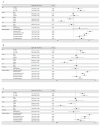Outpatient Antibiotic Prescribing Patterns in Children among Primary Healthcare Institutions in China: A Nationwide Retrospective Study, 2017-2019
- PMID: 38247629
- PMCID: PMC10812453
- DOI: 10.3390/antibiotics13010070
Outpatient Antibiotic Prescribing Patterns in Children among Primary Healthcare Institutions in China: A Nationwide Retrospective Study, 2017-2019
Abstract
There is scarce evidence to demonstrate the pattern of antibiotic use in children in China. We aimed to describe antibiotic prescribing practices among children in primary healthcare institutions (PHIs) in China. We described outpatient antibiotic prescriptions for children in PHIs from January 2017 to December 2019 at both the national and diagnostic levels, utilizing the antibiotic prescribing rate (APR), multi-antibiotic prescribing rate (MAPR), and broad-spectrum prescribing rate (BAPR). Generalized estimating equations were adopted to analyze the factors associated with antibiotic use. Among the total 155,262.2 weighted prescriptions for children, the APR, MAPR, and BAPR were 43.5%, 9.9%, and 84.8%. At the national level, J01DC second-generation cephalosporins were the most prescribed antibiotic category (21.0%, N = 15,313.0), followed by J01DD third-generation cephalosporins (17.4%, N = 12,695.8). Watch group antibiotics accounted for 55.0% of the total antibiotic prescriptions (N = 52,056.3). At the diagnostic level, respiratory tract infections accounted for 67.4% of antibiotic prescriptions, among which prescriptions with diagnoses classified as potentially bacterial RTIs occupied the highest APR (55.0%). For each diagnostic category, the MAPR and BAPR varied. Age, region, and diagnostic categories were associated with antibiotic use. Concerns were raised regarding the appropriateness of antibiotic use, especially for broad-spectrum antibiotics.
Keywords: antibiotic use; appropriateness; broad-spectrum antibiotics; children; diagnostic classification.
Conflict of interest statement
The authors declare no conflicts of interest.
Figures


Similar articles
-
Inappropriate antibiotic prescribing in primary healthcare facilities in China: a nationwide survey, 2017-2019.Clin Microbiol Infect. 2023 May;29(5):602-609. doi: 10.1016/j.cmi.2022.11.015. Epub 2022 Nov 25. Clin Microbiol Infect. 2023. PMID: 36436703
-
Outpatient Antibiotic Prescribing Patterns and Appropriateness for Children in Primary Healthcare Settings in Beijing City, China, 2017-2019.Antibiotics (Basel). 2021 Oct 14;10(10):1248. doi: 10.3390/antibiotics10101248. Antibiotics (Basel). 2021. PMID: 34680828 Free PMC article.
-
Antibiotic prescriptions for children younger than 5 years with acute upper respiratory infections in China: a retrospective nationwide claims database study.BMC Infect Dis. 2021 Apr 12;21(1):339. doi: 10.1186/s12879-021-05997-w. BMC Infect Dis. 2021. PMID: 33845771 Free PMC article.
-
Pattern of Antibiotic Prescriptions in Chinese Children, A Cross-Sectional Survey From 17 Hospitals Located Across 10 Provinces of China.Front Pediatr. 2022 Jul 14;10:857945. doi: 10.3389/fped.2022.857945. eCollection 2022. Front Pediatr. 2022. PMID: 37152767 Free PMC article.
-
Antibiotic prescribing in inpatient and outpatient settings in Iran: a systematic review and meta-analysis study.Antimicrob Resist Infect Control. 2021 Jan 14;10(1):15. doi: 10.1186/s13756-021-00887-x. Antimicrob Resist Infect Control. 2021. PMID: 33446279 Free PMC article.
Cited by
-
Unraveling the Microbial Symphony: Impact of Antibiotics and Probiotics on Infant Gut Ecology and Antibiotic Resistance in the First Six Months of Life.Antibiotics (Basel). 2024 Jun 27;13(7):602. doi: 10.3390/antibiotics13070602. Antibiotics (Basel). 2024. PMID: 39061284 Free PMC article.
References
-
- Adjei A., Kukula V., Narh C.T., Odopey S., Arthur E., Odonkor G., Mensah M.M., Olliaro P., Horgan P., Dittrich S., et al. Impact of Point-of-Care Rapid Diagnostic Tests on Antibiotic Prescription Among Patients Aged < 18 Years in Primary Healthcare Settings in 2 Peri-Urban Districts in Ghana: Randomized Controlled Trial Results. Clin. Infect. Dis. 2023;77((Suppl. S2)):S145–S155. doi: 10.1093/cid/ciad328. - DOI - PMC - PubMed
-
- Global Action Plan on Antimicrobial Resistance. [(accessed on 3 February 2023)]. Available online: https://www.who.int/publications/i/item/9789241509763.
Grants and funding
LinkOut - more resources
Full Text Sources
Miscellaneous

